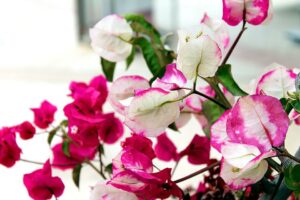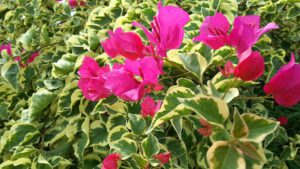Bougainvillea Indoor Care

The bougainvillea plant is a tropical to sub-tropical beauty that is native to South America, this shrub is widely used in outdoor gardens as a hedge. Because bougainvilleas are known as climbers or spreaders they can be planted alongside lattices, fenced areas, arbors, carports, gazebos, etc.
Bougainvilleas are rapid growers, once established these shrubs become drought-tolerant surviving on very little water, for those of you that live in coastal areas this garden beauty is a must-have because of its ability to withstand the salt sprays. But the highlight of the bougainvillea plants is their ability to produce an abundance of beautiful flowers that comes in an array of colors.
Hummingbirds, butterflies, and other nectar-loving insects are attracted to the bougainvilleas, the custom of growing bougainvillea is in an outdoor garden setting but do you know that this plant can be grown indoors to brighten up your indoor living space. If you want to know how this is done continue reading to learn how to grow bougainvilleas successfully indoors.
9 Easy Steps
Light
Because bougainvilleas are tropical t0 sub-tropical plants they require lots of sunlight to perform their best, therefore when growing indoors ensure to locate in an area that gets a lot of sunlight. A south or west-facing window is the ideal spot.
Soil
Bougainvilleas require a moist well-drain potting mix to thrive, the potting mix should be slightly acidic anywhere from 5.5 and 6.0 pH. If you are potting the soil your self the pot should have drain holes for water drainage. The pot should be large enough to accommodate your bougainvilleas root ball. If you’re not sure about the pot size you can always get this information from your garden nurseryman.
Water
During the spring, summer, and fall months keep your bougainvillea evenly moist, once the colder months arrive decrease watering, during this time of the year the soil should be somewhat on the dry side. However when watering your bougainvillea during the hotter months water to the point where the soil gets saturated and then allow the soil to try.
You may have to remove the pot outdoors to water, once the pot drip-dries return indoors. You may have to get help when lifting the pot because of the weight.

Fertilizer
To keep your bougainvillea growing nicely with lots of beautiful flower blooms fertilize once a week or every ten days with a fertilizer that’s formulated for bougainvilleas or you can opt to use a weak or diluted liquid fertilizer.
Temperature and Humidity
The ideal indoor temperature and humidity level for bougainvilleas can be about 60 to 70 degrees Fahrenheit, adding a small humidifier will help in keeping the indoor air from drying out which will promote the health of your bougainvillea.
Pests Issues
When growing bougainvilleas outdoors the main pests problems are the bougainvillea loppers and aphids, the main pests issues of indoor bougainvilleas are mealybugs. Mealybugs are fuzzy white soft-bodied insects that appear on the stems and the leaves, mealybugs are among a group of insects class as sucking insects, mealybugs suck the plant’s fluids causing yellowing of the leaves followed by leaf drop. The use of insecticidal soap or neem oil will bring control. For the best results read and follow the manufacturer’s directions.
Disease Issues
The main issue when growing bougainvilleas indoors is root rot because of overwatering, the soil of indoor-grown bougainvilleas should be somewhat moist not waterlogged or water-saturated. Always check the soil before watering, a soil probe or soil moisture meter can help with this. A soil probe or a soil moisture meter can be purchased from your garden center or plant nursery.
Pruning
Although bougainvilleas will not grow as rapidly indoors as outdoors you may have to keep pruning to control the extra growth so the plant can maintain its natural form.
Repotting
Your bougainvillea will eventually outgrow its pot size therefore it’s important to re-pot in a larger pot because once the root ball gets too big for the pot and if left in that state will lead to root-bound which will lead to more frequent watering which will affect the health of the plant.
The final word on growing bougainvillea Indoors
Growing bougainvilleas indoors is that simple, all it requires is some know-how and you will be on your way to having much success. Why grow this garden beauty outdoors only when you can also make this beautiful flowering plant a part of your indoor living space? I love bougainvilleas because of their low-maintenance ability and their beauty. Grow your very own indoor bougainvillea and enjoy their colorful presence as you connect with nature indoors.
About the author
Norman loves being in the garden, both at home and for his job....
he is 'Natures Little helper' being outdoors, growing his vegetables and flowers from an early age.
Now having spent over 22 years in the profession he want to give some of his knowledge to others...
his vast array of hints and tips you will find scattered over this site will help you no end growing plants in your garden.

Although the bougainvillea flower itself is not respectable, its flowering leaves, which are available in different shades of orange and yellow to shades of pink and purple, contribute to the plant looking beautiful and luxurious. The colors of the bracts change as the plant ages, so over time, the shades take on a lighter or darker color.
The most luxurious and lush are bougainvillea, 4 to 5 years old, when they reach the peak of their beauty and enrich every space.
Thank you so much for stopping by and sharing, all the best to you, and have a good day.
Thank you, Norman for your article on Bouganivillia. This plant has a special place in my heart as it was one of my Mothers favorite plants. Our whole family was a gardening family, and I fondly remember the weekends spent with my father in the vegetable garden and with my Mother in her flower beds. My mothers first joy was roses followed closely by bouganvilleas. We had a carport with brick poles and it had a magnificent display of crimson/red bougainvillea.
This was in New Zealand which may have been a challenge weather-wise for her. But I never saw her try to grow them inside. And what a wonderful idea. I know they drop their flower petals so how do you overcome that, or is it just continual cleaning.
Also, they tend to be a climbing plant so can they adapt to a pot where they hang down. And if I did put them into a hanging pot arrangement how often would I need to re-pot them?
You said a liquid fertilizer is the best, is there any way I could make my own organic fertilizer as I am allergic to a lot of chemicals?
But I would love to do this, just to bring back memories of my Mother.
Many Thanks
Stephen
You are welcome Steve, it is so good to remember those wonderful childhood days, I have some of my own also. Well for the most part after a plant’s bloom period they tend to drop flowers but this should not be an issue indoors as long as you follow the guide that I laid out.
The good thing is because bougainvilleas are climbers they can be trained to grow on a trellis, re-potting your bougainvillea all depends on how fast your plant outgrows the pot. If I was to give a time frame probably once a year or maybe once every two years.
As far as homemade organic fertilizers are concerned you may want to take a look at this https://gardenofedengardencent…I am glad that I could help and thanks so much for stopping by and sharing. All the best to you and please let me know how it goes.
I live in Southern California. I would love to plant some dwarf bougainvillea in a small area (approx. 3 ft by 8 ft) adjacent to the house. I do not want it to climb but prefer to keep it trimmed in “bush like” fashion which I assume can be done with the dwarf variety. Problem is I can’t find any in my area, Orange County. Do you know where I might be able to order them on line?
Thanks for any suggestions.